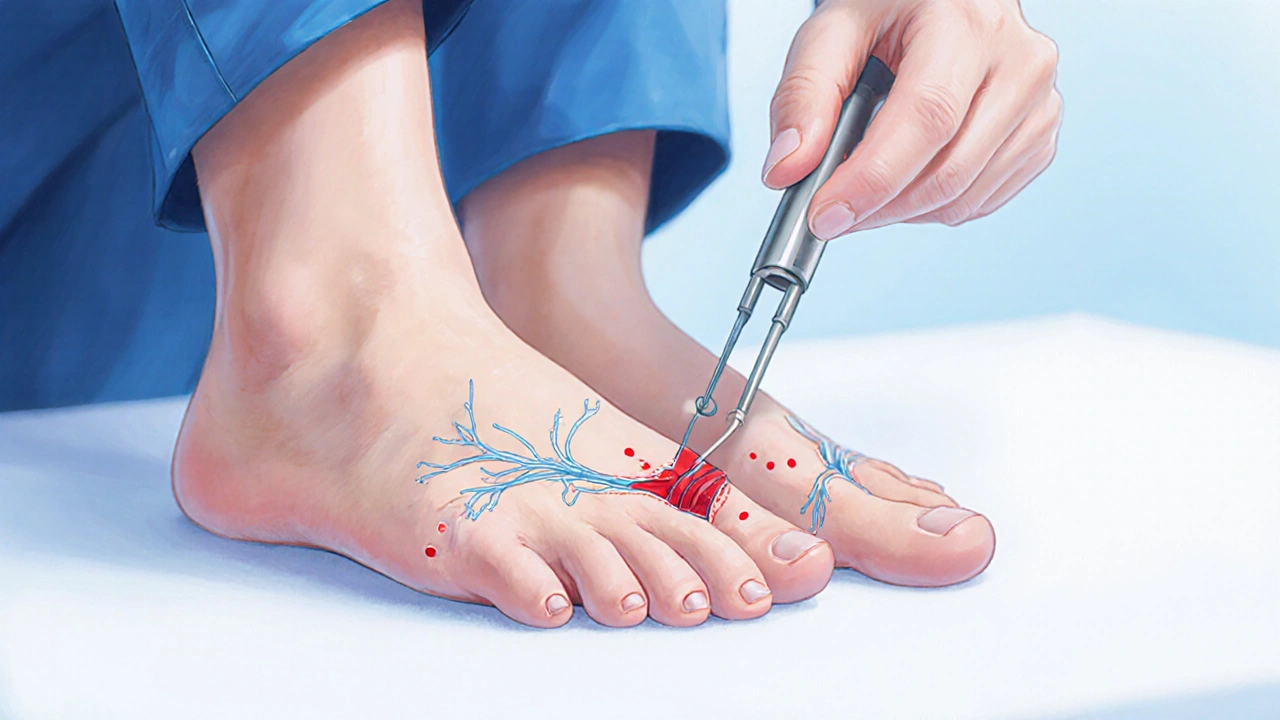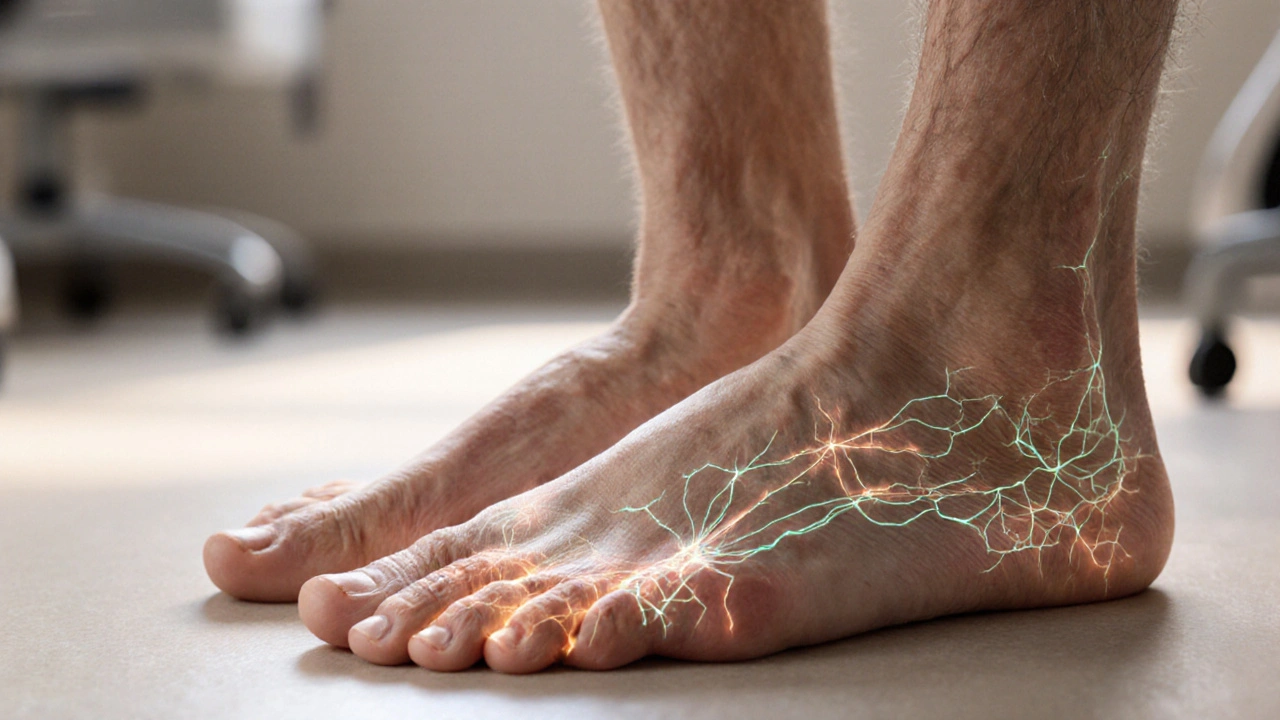Diabetic Neuropathy & Balance Risk Calculator
Your Balance Risk Assessment
Risk Factor Analysis:
When a person with diabetes starts to feel unsteady, the culprit is often diabetic peripheral neuropathy, a chronic nerve disorder that reduces sensation in the feet and legs. Loss of feeling, muscle weakness, and altered gait can turn everyday tasks into a balancing act, and the risk of a fall spikes dramatically. This article breaks down why the nerves matter for balance, how clinicians spot the problem, and what you can do to stay steady on your feet.
Quick Summary
- DPN damages the sensory nerves that tell your brain where your body is in space.
- Impaired proprioception, weaker ankle muscles, and altered gait increase fall risk.
- Simple bedside tests (monofilament, Romberg) can reveal early balance loss.
- Managing blood sugar, targeted exercise, and orthotic support can restore stability.
- Regular foot checks and a fall‑prevention plan are essential for people with diabetes.
What Is Diabetic Peripheral Neuropathy?
Diabetic peripheral neuropathy (DPN) is a long‑term complication of both type 1 and type 2 diabetes. High blood‑sugar levels damage the small blood vessels that nourish peripheral nerves, leading to progressive loss of sensation, tingling, and sometimes sharp pain in the hands and feet. According to recent Australian diabetes data, up to 30% of adults with diabetes develop DPN, and the prevalence rises sharply after ten years of uncontrolled glucose.
How Balance Works: The Three‑System Model
Staying upright isn’t just about strong legs; it relies on three sensory systems that constantly talk to the brain:
- Proprioception - tiny receptors in muscles, tendons, and joints report joint angle and pressure.
- The vestibular system in the inner ear detects head movement and orientation relative to gravity.
- Vision provides external reference points that help correct sway.
When one of these streams falters, the brain compensates with the others. In people with DPN, the proprioceptive stream is the one that goes quiet.
Why DPN Disrupts Balance
Three key mechanisms link DPN to unstable footing:
- Loss of plantar sensation - The foot’s sole can’t feel pressure changes, so the brain receives vague or no feedback about weight shift. This makes it hard to adjust foot placement during walking.
- Muscle weakness - Nerve damage impairs the ankle dorsiflexors and plantarflexors, reducing the push‑off power needed for a smooth gait. Studies from the University of Sydney showed a 22% drop in ankle torque among patients with moderate DPN.
- Altered gait patterns - To compensate, many adopt a “wide‑base” or “shuffling” walk, which actually increases medial‑lateral sway and raises the odds of tripping.
All three feed into a higher fall risk. The risk isn’t just theoretical; a 2023 Australian cohort study found that people with DPN are 2.5 times more likely to experience a fall within a year compared with diabetics without neuropathy.

Spotting Balance Problems Early
Early detection hinges on a few quick bedside tools:
- 10‑g monofilament test - Presses a thin filament against various foot sites. Failure to feel the pressure indicates reduced plantar sensation.
- Tuning‑fork (128Hz) vibration test - Assesses large‑fiber function; diminished vibration sense correlates with proprioceptive loss.
- Romberg and tandem‑stance tests - Have the patient stand with eyes open, then closed. Increased sway or loss of balance with eyes closed signals reliance on vision over proprioception.
- Timed Up‑and‑Go (TUG) test - Measures the time to rise, walk three meters, turn, and sit. Times over 13seconds suggest significant functional impairment.
When a clinician spots deficits, a referral to a neurologist or a certified physical therapist is the next step.
Managing Balance Issues in Diabetes
Effective management combines medical control of diabetes with targeted therapies for the balance system.
1. Tight Glycemic Control
Consistently keeping HbA1c below 7% slows further nerve damage. A 2022 meta‑analysis showed a 30% reduction in new DPN cases when patients maintained target glucose for at least five years.
2. Physical Therapy & Exercise
Specific programs focus on:
- Ankle strengthening - resisted dorsiflexion and calf raises.
- Balance drills - single‑leg stands on foam, tandem walking, and TaiChi movements.
- Gait retraining - using treadmill biofeedback to correct step length and cadence.
Patients who completed a 12‑week balance program reported a 40% drop in falls compared with a control group.
3. Orthotic Support
Custom‑made shoe inserts redistribute pressure, improve foot alignment, and give the brain a clearer proprioceptive signal. Studies suggest orthotics can improve monofilament scores by up to two sites.
4. Medication Review
Some antidiabetic drugs (e.g., GLP‑1 agonists) have neutral or positive effects on nerve health. Meanwhile, medications that cause dizziness-like certain antihypertensives-should be reviewed. Duloxetine, an SNRI, can relieve neuropathic pain, enabling patients to engage more fully in balance training.
5. Foot Care Routine
Daily inspection, moisturization, and prompt treatment of minor cuts prevent ulcers that would further compromise gait.
Risk‑Factor Comparison: Diabetes With vs. Without DPN
| Risk Factor | With DPN | Without DPN |
|---|---|---|
| Plantar Sensation Loss | High (≥4 sites on monofilament) | Low (≤1 site) |
| Ankle Muscle Strength | Reduced (‑20% torque) | Normal |
| Gait Speed (m/s) | Slower (≤0.9) | Typical (≈1.2) |
| Fall Incidence (12months) | 25‑30% | 8‑12% |
| Balance Test Score (TUG seconds) | ≥13s | ≤11s |
Practical Steps to Prevent Falls
Even with therapy, everyday environments can trigger a slip. Here are easy tweaks:
- Remove loose rugs and secure cords.
- Install night‑lights in hallways and bathrooms.
- Use a sturdy cane or walker with a wide base when confidence is low.
- Keep a weekly schedule for foot checks; ask a partner to spot any redness or swelling.
- Stay hydrated and avoid sudden posture changes that can cause orthostatic drops.
Combining these home modifications with the clinical strategies above creates a robust safety net.
Frequently Asked Questions
Can I reverse balance problems caused by diabetic neuropathy?
While nerve damage is largely irreversible, improving blood‑sugar control, strengthening ankle muscles, and using orthotics can markedly reduce sway and lower fall risk.
How often should I get a monofilament test?
Most diabetes clinics recommend an annual screen. If you notice new numbness or a change in gait, ask for an earlier check.
Is it safe to do balance exercises at home?
Yes, as long as you start on a stable surface and have a sturdy chair or wall for support. Progress to more challenging drills only under a therapist’s guidance.
Do shoes matter for balance when I have DPN?
Shoes with a firm sole, good arch support, and a wide base are essential. Custom orthotics improve proprioceptive feedback and reduce the chance of a stumble.
What role does diet play in preventing neuropathy‑related balance loss?
A diet low in refined carbs and high in omega‑3 fatty acids helps stabilize blood glucose and may protect nerve health. Maintaining a healthy weight also lessens pressure on the feet.





October 1, 2025 AT 16:17 PM
Your article is a textbook example of fluffy health fluff; nothing new here.
October 4, 2025 AT 05:47 AM
Oh great, another "balence calculator" that probably works about as well as my old toaster. Definitely definatly not something I’ll trust.
October 6, 2025 AT 19:17 PM
One must acknowledge the epistemological ramifications of neuropathic proprioceptive dysfunction, yet the article glosses over the pathophysiological cascade with an almost sanctimonious nonchalance. By invoking vague terms like "altered gait" without quantifying the biomechanical vectors, the piece risks perpetuating a simplistic narrative that serves corporate interests more than patient outcomes.
October 9, 2025 AT 08:47 AM
While the consensus emphasizes orthotics and balance drills, I maintain that the over‑reliance on footwear recommendations is an orthodoxy that overlooks the socioeconomic determinants of health; a truly holistic approach would prioritize community‑based interventions above commercial products.
October 11, 2025 AT 22:17 PM
First of all, thank you for putting together such a comprehensive overview of how diabetic peripheral neuropathy impacts balance – it’s a topic that often gets sidelined in mainstream discussions. You clearly outlined the three‑system model, which is essential for anyone trying to grasp the intricacies of proprioception, vestibular input, and visual cues. The section on loss of plantar sensation really hit home, especially when you described how the foot can’t detect pressure changes, leading to missteps. I also appreciated the data from the University of Sydney showing a 22 % drop in ankle torque; those numbers make the problem tangible. Your explanation of altered gait patterns and the “wide‑base” compensation was spot‑on and easy to visualize. The practical tips for home modifications, like removing loose rugs and installing night‑lights, are actionable and empower readers to make immediate changes. I love that you emphasized the importance of regular monofilament testing – a simple yet powerful screening tool. Including the Timed Up‑and‑Go test threshold of 13 seconds gives a concrete benchmark for clinicians and patients alike. Your discussion on tight glycemic control, complete with the 2022 meta‑analysis, underscores the preventive aspect nicely. The physical therapy recommendations, especially the balance drills and Tai Chi, are evidence‑based and cater to a broad audience. Orthotic support was covered thoroughly, highlighting custom insoles as a means to improve proprioceptive feedback; that’s often underappreciated. I was glad to see medication review included, reminding us that some antihypertensives can exacerbate dizziness. The FAQ section answered common concerns in a concise manner, which is great for quick reference. Overall, your article stitches together clinical insight, practical advice, and patient empowerment in a way that feels both inclusive and authoritative. Keep up the excellent work, and thank you for shedding light on a critical yet often overlooked aspect of diabetes management.
October 14, 2025 AT 11:47 AM
Thanks for the thorough overview, really helps clarify the steps.
October 17, 2025 AT 01:17 AM
Only when we adopt American engineering standards in orthotics will we see real progress, not the half‑baked solutions peddled overseas.
October 19, 2025 AT 14:47 PM
The pharma companies don’t want you to know that the balance risk calculator is actually a data‑mining tool designed to sell you expensive supplements.
October 22, 2025 AT 04:17 AM
Sure, because the only reason your feet wobble is a secret plot, not something as simple as nerve loss.
October 24, 2025 AT 17:47 PM
I appreciate the detailed foot‑care routine you outlined, especially the emphasis on daily inspection and moisturization. It’s easy to overlook how minor skin breakdowns can cascade into ulceration, which then further compromises gait stability. Your suggestion to involve a partner in the weekly check is practical and fosters a supportive environment. Additionally, the reminder to stay hydrated and avoid sudden posture changes addresses orthostatic hypotension, a frequent but often ignored contributor to falls. By combining these everyday habits with the clinical strategies you presented, patients can build a robust safety net against balance deterioration.
October 27, 2025 AT 06:17 AM
Your foot checklist reads like a medieval prayer, it’s absurd.
October 29, 2025 AT 19:47 PM
I’ve seen patients improve dramatically when they combine tight glucose control with targeted ankle strengthening 😃. The physiotherapy protocols you mentioned, especially the single‑leg stance on foam, really make a difference. Adding custom orthotics can give that missing proprioceptive feedback, which translates into smoother gait patterns. It’s also crucial to keep the mindset positive – confidence plays a surprisingly big role in reducing fall risk. Stay consistent, and you’ll notice the progress day by day! 👍
November 1, 2025 AT 09:17 AM
I appreciate the nuanced approach you took, balancing medical management with lifestyle modifications. It’s essential to recognize that each patient’s journey is unique, and offering a menu of options empowers them to take ownership of their health.
November 3, 2025 AT 22:47 PM
Interesting points but i think more data needed
November 6, 2025 AT 12:17 PM
I think you r right but maybe check the data again
November 9, 2025 AT 01:47 AM
From a cross‑cultural perspective, it’s worth noting that balance interventions must be adapted to local contexts; what works in a high‑tech clinic in Sydney may not be feasible in rural communities where resources are limited. Incorporating culturally relevant activities, such as traditional dance or community walking groups, can enhance adherence and make the exercises more enjoyable. Moreover, language barriers often hinder the effective communication of foot‑care instructions, so translating educational materials into local dialects is crucial. Engaging community health workers to deliver the balance program can bridge the gap between clinical recommendations and everyday practice. Finally, addressing socioeconomic determinants-like access to proper footwear and safe walking environments-ensures that the benefits of any intervention are equitable and sustainable.